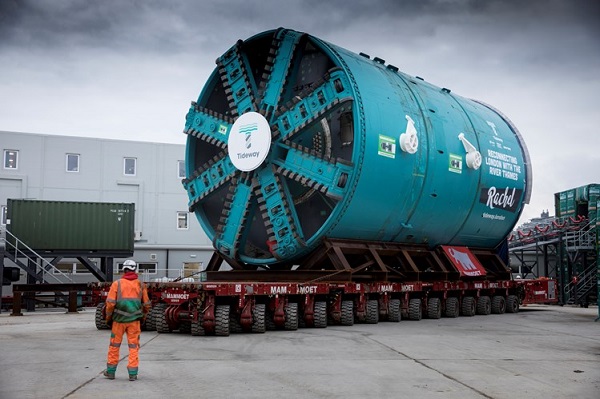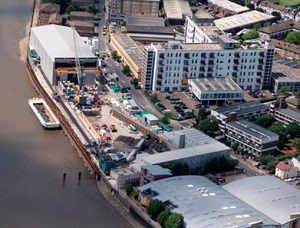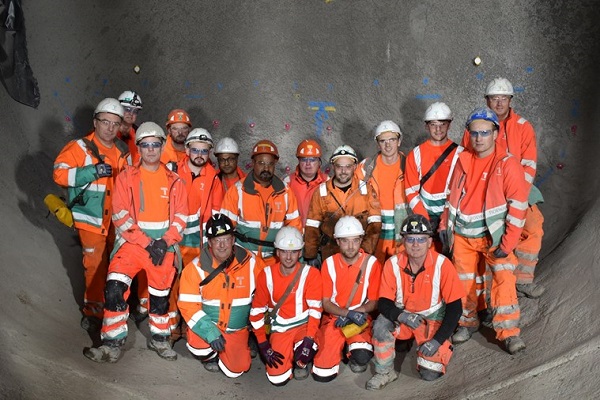Tideway Tunnel Boring Machine Rachel Heads West to Acton
While Charlotte and Millicent dig deep under river from Wandsworth to Fulham

Tunnel boring machine Rachel
Rachel has completed the first kilometre of her 7km journey from Fulham to Acton.
She began the journey earlier this year after being lowered 35 metres into the ground at Tideway's Carnwath Road Riverside site in Fulham.

Once complete, this section of the tunnel will mark the 'start' and shallowest part of London's new super sewer.
The super sewer is currently under construction deep beneath the Thames to prevent millions of tonnes of sewage pollution entering the river each year.
Four giant machines are being used to create the main tunnel, with three well underway across the capital.
Each of these giant machine was named after an inspirational woman from history with ties to the local area, with Rachel named after Rachel Parsons, pictured on the right. She was the founding president of the Women's Engineering Society and a former Fulham resident.
Two other slightly smaller machines are being used to create connections into the main tunnel, one from Greenwich and another, named after suffragist Charlotte Despard, digging the Frogmore Connection Tunnel from Wandsworth to Fulham.
This 1.1km tunnel will take sewage overflows from King George’s Park in Wandsworth into the main 25km super sewer at Fulham, where it will be transferred to east London for treatment instead of polluting the River Thames.
The 500m southern section of the Frogmore Connection Tunnel, from Dormay Street to King George’s Park, is now complete.
Charlotte will now be lifted from the shaft, taken back to Dormay Street and placed back into the ground to tunnel 600 metres north under the river to Fulham.
Sally Cox, Project Director for the west section of the project, said: "This breakthrough, the first on the Tideway project, marks another key step toward a cleaner, healthier River Thames.
"Despite being the smallest TBM on the Tideway project, Charlotte is creating vital infrastructure that will benefit Londoners and their river for many years to come."
“Our tunnelling team has done a fantastic job getting this machine to King George’s Park and will now focus on completing the northern section of the Frogmore Connection Tunnel."
Charlotte is a three-metre-wide machine and more than 70 metres long, while the Frogmore Connection Tunnel is being created at a depth of around 30 metres.
The first section of the main tunnel is also close to completion, as another tunnelling machine, called Millicent, approaches Fulham's Carnwath Road after tunnelling almost 5km from Kirtling Street next to Battersea Power Station.
A 300m long connection tunnel was also completed earlier this year between Hammersmith Pumping Station and the middle of the River Thames. It will eventually connect into the 25km Thames Tideway Tunnel.
Hammersmith Pumping Station currently spills around a million tonnes of untreated sewage into the Thames each year on average, making it one of the most polluting overflow points along the River Thames.
The tunnel is 5.1m in diameter for the first 50m, then narrows down to 4m diameter. It is the first fully excavated tunnel as part of the 'super sewer' project and will come into operation once work is complete in 2024.
Morgan Anamoah, Project Manager at Tideway, said: "Although it’s not the biggest on the project, this is the first fully excavated tunnel for the super sewer, a huge step in our work towards cleaning up the River Thames.
" Our work in Hammersmith will help stop one of the most polluting sites along the river and it is something we’re all immensely proud of."

The team at Hammersmith Pumping Station
So far, 8km of the Thames Tideway Tunnel has been built, with four tunnelling machines in the ground.Once complete in 2024, the tunnel will help stop tens of millions of tonnes of raw sewage pouring into the river every year.
November 5, 2019
